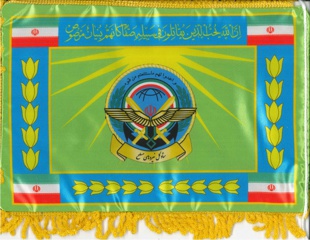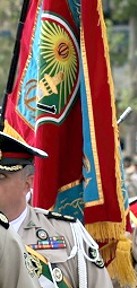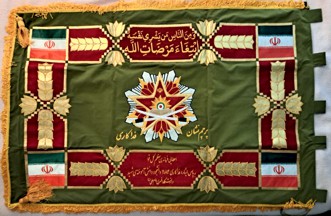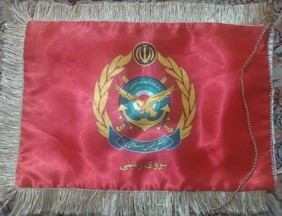Iran Armed Forces flags (original) (raw)

This page is part of © FOTW Flags Of The World website
Last modified: 2024-08-17 by ian macdonald
Keywords: iran | army |
Links: FOTW homepage |search | disclaimer and copyright | write us | mirrors
- Introduction
- Islamic Republic of Iran Army (IRIA)
- General Staff flag
- Chief of Army Command flag
- Army ceremonial flag
- Velayat/Army Flag
- IRGC Command & General Staff College flag
- Army for Coordination joint command flag
- Artesh Joint Staff
- Khamenei Honor Guard (Supreme Leader)
See also:
- Pasdaran - Army of the Guardians of the Islamic Revolution
- Army Ground Forces flags
- Air Force flags
- Navy flags
- Iran
Introduction
The Armed Forces of the Islamic Republic of Iran (Persian: نيروهای مسلح جمهوری اسلامی ايران) include the IRIA (ارتش جمهوری اسلامی ایران), the Army of the Guardians of the Islamic Revolution (سپاه پاسداران انقلاب اسلامی) and the Law Enforcement Force (نيروی انتظامی جمهوری اسلامی ایران).
Source: http://en.wikipedia.org/wiki/Armed_Forces_of_the_Islamic_Republic_of_Iran
Islamic Republic of Iran Army (IRIA)
[ ![[Islamic Republic of Iran Army (IRIA)]](http://www.crwflags.com/fotw/images/i/ir^army.gif) ](../images/i/ir^army.gif) image by Zoltan Horvath, 1 December 2014
](../images/i/ir^army.gif) image by Zoltan Horvath, 1 December 2014
Ceremonial flag
 image located by William Garrison, 30 August 2019
image located by William Garrison, 30 August 2019
The ارتش جمهوری اسلامی ایران , abbreviated as آجا (English: Army of the Islamic Republic of Iran, abbreviated as AJA) is directed by the (Army) Joint Headquarters (English: Joint Staff), which coordinates its four branches: the Ground Forces (NEZAJA), Air Force (NAHAJA), Navy (NEDAJA) and the Air Defense Force (PADAJA).
Esteban Rivera, 31 August 2019
General Staff flag
 image located by William Garrison, 30 August 2019
image located by William Garrison, 30 August 2019
 image located by William Garrison, 4 September 2019
image located by William Garrison, 4 September 2019
"Setsad-e Koll-e Niroohay-e Mosallah" = "General Staff of the Armed Forces" (ceremonial flag)
William Garrison, 4 September 2019
 image located by William Garrison, 3 July 2024
image located by William Garrison, 3 July 2024
In this derafsh (ceremonial flag), beneath the main logo/seal, is the Farsi yellow-script slogan: "Setsad-e Koll-e Niroohay-e Mosallah" or, in English: "General Staff of the Armed Forces" (GSAF). At the right hoist side there are 5 cloth tabs for the insertion of a flag-pole. The GSAF is the most senior military body in Iran, to implement policy, monitor and coordinate the activities of three armed commands: (1) the "Armed Forces" [Artesh: which consists of the Army, Navy & Air Forces] (for domestic defense), (2) the "Iranian Revolutionary Guards Corps" [IRGC/Sepah/Pasdaran] (for offensive ops), and (3) Iran's civilian-police force: the "Law Enforcement Command" [NAJA]. Iran's "Supreme Leader" (Ali H. Khamenei, c. 2024) controls the GSAF. Iran's "Ministry of Defence and Armed Forces Logistics" is responsible for planning and funding of the armed forces, but it reports to Iran's "president" - who is submissive to the "Supreme Leader".
William Garrison, 3 July 2024
Army ceremonial flag
 image located by William Garrison, 5 September 2023
image located by William Garrison, 5 September 2023
Red-field Artesh (army) derafsh (ceremonial) flag. Different from similar sun-imaged flags as the black-colored national "Allah" emblem/logo of Iran is displayed inside the sun.
William Garrison, 5 September 2023
Chief of Army Command flag
 image located by William Garrison, 2 May 2022
image located by William Garrison, 2 May 2022
Source:https://www.farsnews.ir/en/news/14010131000340/IRGC-Cmmander-Underlines-Prdcin-f-Mre-Advanced-Elecrnic-Warfare
TEHRAN (FNA)- Commander of the Islamic Revolution Guards Corps (IRGC) Major General Hossein Salami in a meeting with Iranian Army Commander Major General Seyed Abdolrahim Moussavi stressed the need for the development of more advanced electronic warfare to defend the country.
http://www.farsnews.ir
Three flags: (left-to-right): Iranian national flag; Iranian Artesh/Army flag; (far right) unknown light-olive-green Iranian Army flag (maybe a new variety of some Chief of Army Command flag). Commander of the "Islamic Revolution Guards Corps" (IRGC) Major General Hossein Salami (left) in a meeting with Iranian Army Commander Major General Seyed Abdolrahim Moussavi (right).
William Garrison, 2 May 2022
 image located by William Garrison, 29 May 2023
image located by William Garrison, 29 May 2023
A clearer photo of the Chief of Army Command flag.
Velayat/Army Flag
[ ![[Velayat/Army derafsh]](http://www.crwflags.com/fotw/images/i/ir^velay.gif) ](../images/i/ir^velay.gif) image located by Bill Garrison, 30 September 2019
](../images/i/ir^velay.gif) image located by Bill Garrison, 30 September 2019
IRI [Islamic Republic of Iran] the Islamic Republic of Iran Army [Artesh-e Jomhouri-ye Eslami-ye Iran, or "Artesh" in short] = "Army or joint military logo".
"Army" logo: incorporates all 3 military branches: Army (swords), Air Force (falcon) & Navy (anchor) designs. The "ground forces" refers to what most countries call their "army" (but in Iran the "army" is comprised of all 3 branches). "derafsh" (Farsi/Persian) = colorful ceremonial flag.
This "sun ray"-design flag ("derafsh" or colorful ceremonial flag) is referred to as the "Derafsh of Velayat" or "flag of the Chief Jurist", who is called the "Vali-e Faqhih" (Guardian Jurist). He guides the Iranian government as its "Velayat-e faqih" (the office of the "Guardianship of the Islamic Jurist" or "Governance of the Jurist") [that being Ali Hosseini Khamenei c. 2019]. Shia Islam postulates that Islam gives a https://en.wikipedia.org/wiki/Faq%C4%ABh (Islamic jurist) custodianship over people. The constitution of Iran calls for a faqih, or Vali-ye faqih (Guardian Jurist) to serve as the "Supreme Leader" (rahbar-e mo'azzam) of the government. He also serves as the commander-in-chief of the armed forces and controls foreign policy. He is superior to the president [being Hasan Rouhani c. 2019] of Iran (Rayis Jomhur-e Irān) who implements the national economic policies of the country, and who represents the country at diplomatic events.
This flag is displayed at state functions when the Iranian president receives foreign dignitaries or when he participates in public events -- such as in parades. Although this flag is known as the "Joint Chiefs of the Army" flag, it is nicknamed the "Derafsh of Velayat" -- as Iran's first velayat and military commander-in-chief [Ayatollah R. Khomeini c. 1980s] presented it to the Iranian Army ("artesh") --which includes the combined army, air force and navy. So while this derafsh is perceived as a military flag, it also represents the office of the government's civilian leader (velayat) who commands the military. Therefore, it is regarded as the "most important" of all the derafsh or colorful ceremonial flags. The word "Allah" appears at the top of the yellow sun's rays. [In the photo one sees the former Iranian Pres. M. Ahmadinejad bowing to the Velayat flag in respect to the office (velayat) of his boss: the Iranian "Supreme Leader" (rahbar-e mo'azzam), c. Oct. 2007 -- then being Ayatollah Ali Hosseni Khamenei].
William Garrison, 30 September 2019
I've seen a photo of the same flag with escort captioned as 'The Honor Guard'; but I don't know whether the Honor Guard are a presidential guard unit, or something else entirely. It's not a straightforward Iranian regimental colour, which does not have the tassels at the corners, and has the national flag placed diagonally in each corner. The central device of a regimental colour appears to be a slightly less elaborate version of the one on display here. Other photos of the Honour Guard are postedhere andhere.
Ian Sumner, 24 October 2007
Presidential Honour Guards Flag is simply one of the multiple duties of this flag. It is also the general - MP (Military Police)/Central Provost of Islamic Republic of Iran Army (Persian: دژبان مرکز ارتش جمهوری اسلامی ایران; De�bān Markaz), acronymed DEJAJA (Persian: دژاجا), and represents the provost and military police with an authority within all military branches of theIslamic Republic of Iran Army. The provost is a subdivision to the military's (English: Joint Staff, sometimes referred to as General Staff) and has seniority over designated provosts �like the "Sea Police" (Persian: پلیس دریائی) of (the) Navy and the "Air Police" (Persian: پلیس هوائی) in the Air Force.
The provost is also responsible for performing ceremonial duties; it has honor guard units, including the "Presidential Ceremony Guard" (Persian: گارد تشریفات ریاست جمهوری). It was established on October 1, 1330 (Persian calendar, equivalent to 1951.
Sources:https://fa.wikipedia.org/wiki andhttps://en.wikipedia.org/wiki/Central_Provost_of_Islamic_Republic_of_Iran_Army
The flag can be seen second from left to right):
https://bayanbox.ir/view/8914791540297656794/44337-636.jpg, source:https://majalenezami.blog.ir/tag/
Esteban Rivera, 5 October 2019
IRGC Command & General Staff College flag
 image located by William Garrison, 30 August 2019
image located by William Garrison, 30 August 2019
Army for Coordination joint command flag
 image located by William Garrison, 23 April 2022
image located by William Garrison, 23 April 2022
Sourcehttps://iranpress.com/content/34177/enemy-afraid-iran-defense-capabilities-admiral-sayyari
Caption: an image of an Iranian military flag. The article is about as clear-as-mud in trying to identify which military unit this flag represents. As the article refers to Iranian Rear Admiral H. Sayyari, is this a "navy" flag, or, if we remember that the Iranian navy is actually part of the overall Iranian "Artesh" (military) -- this flag is in the bigger joint army-navy "Artesh"; so, this could be the flag of the joint "Army for Coordination" command element (which is mentioned in the article). c. Feb. 2021. The "Army for Coordination" is most likely not a real "army" of many soldiers, instead it is probably some small, command-coordination staff -- somehow is worthy of its own flag. [Pictured: Rear Admiral Habibollah Sayyari, the Deputy Chief of the Army for Coordination; Feb. 2021.]
William Garrison, 23 April 2022
Artesh Joint Staff
 image located by William Garrison, 31 January 2024
image located by William Garrison, 31 January 2024
A desktop flag of the Iran Artesh military's "Joint Staff", the bottom golden Farsi slogan reads: "Joint Staff"; c. 2023. Iran has two separate yet similar military systems: (a) the Artesh and (b) the IRGC. The Artesh has about five times the number of military personnel than has the IRGC. Both have their own "ground forces" i.e. "army", as well as their own air forces and navies. The Artesh is the primary military system to "defend" Iran from attack, or go on the overt offense, as during the 1980s war with Iraq. The IRGC is tasked with (a) suppressing domestic political opposition to the "vilayet" theological political system, and (b) providing and promoting "covert-offense" pro-Shia/Shiite "militias" throughout the Levant (Middle East) region to expand Iran's interests therein - such as through the "Quds Force" or the "Popular Mobilization Forces". These militias are used to "influence" other neighboring governments to follow Iran's political agenda and provide attacks against Israel, without directly implicating Iran. The Iranian "General Staff" coordinates intermixing "Joint Service" military activities between the Artesh and the IRGC. Whereas the Artesh "Joint Staff" coordinates the military activities within its own army, navy, aerospace, & air forces. The IRGC has its own "Joint Staff" (although I do not see a flag for it). Sometimes there can be confusion between the wording of "general staff" versus "joint staff", as their organization can change.
William Garrison, 31 January 2024
Khamenei Honor Guard (Supreme Leader)
 image located by William Garrison, 12 January 2021
image located by William Garrison, 12 January 2021
Source: https://fa.wikipedia.org/wiki/
Caption: Flag carried in parade during the funeral of Mohsen Fakhrizadeh at the Iranian Ministry of Defense headquarters in Theran, Iran on 30 Nov 2020. The black slogan reads: "Labbaik-a Ya Khamenei" or "For Honor of our Leader Khamenei" who is the current "Supreme Leader" of Iran. Beneath the slogan is the logo of the defensive "Artesh" military system (which is composed jointly of the army, navy & air force; but is separate from the offensive-oriented "Pasdaran" military system). This flag is like a military Honor Guard flag for Khamenei. Fakhrizadeh was allegedly the director of the organization running Iran's nuclear-weapons program. He was assassinated on 27 Nov 2020 in a road ambush in Absard outside of Tehran, Iran.
William Garrison, 12 January 2021